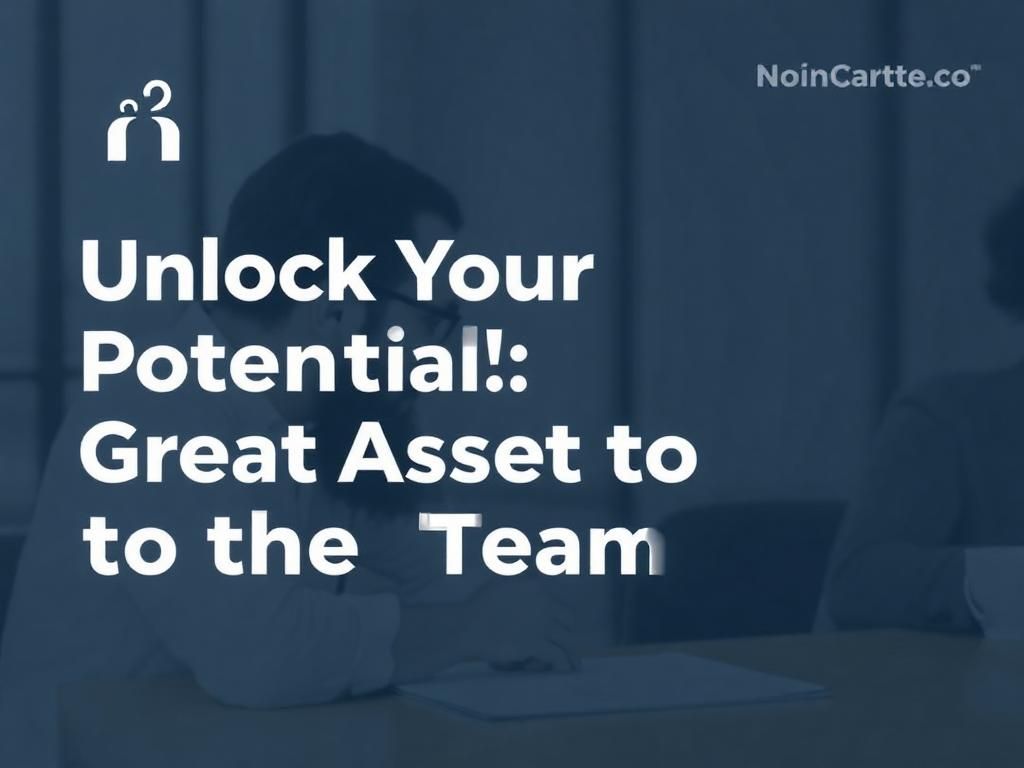The significance of teamwork in today’s professional landscape cannot be overstated. In an era where collaboration often leads to success, becoming a great asset to the team is not just beneficial; it’s essential. Being a great asset means more than just fulfilling your job description; it involves contributing positively to team dynamics, supporting colleagues, and continuously developing your own skills. This article will explore the key characteristics of a great team asset, the importance of collaboration, personal development, practical steps for improvement, and case studies that illustrate effective teamwork.
Characteristics of a Great Asset to the Team
Strong Communication Skills
Effective communication is the cornerstone of teamwork. Both verbal and nonverbal communication play significant roles in conveying ideas, sharing feedback, and fostering understanding.
– Verbal Communication: It’s essential to articulate thoughts clearly and respectfully. This reduces misunderstandings and fosters a culture of openness.
– Nonverbal Communication: Body language, eye contact, and facial expressions contribute to the message being conveyed and can enhance or hinder communication.
– Listening: An often-overlooked element, listening is a vital skill that shows respect for others’ ideas and input.
Encouraging open dialogue and providing constructive feedback can transform a group of individuals into a cohesive unit.
Reliability and Dependability
Team success heavily relies on individuals who are dependable.
– Meeting Deadlines: Consistently meeting deadlines demonstrates commitment and accountability, essential traits for a great asset to the team.
– Building Trust: When team members can rely on each other, trust is built, which promotes a healthy and productive work environment.
– Managing Responsibilities: Juggling multiple responsibilities efficiently is key to productivity. Prioritizing tasks and being organized can enhance reliability.
Flexibility and Adaptability
The ability to adapt to changing circumstances is vital in a fast-paced work environment.
– Embracing Change: Teams that adapt swiftly to changes can navigate challenges more effectively.
– Handling Criticism: Accepting constructive feedback gracefully can lead to personal and professional growth.
– Adjusting Roles: Sometimes roles within a team shift. A flexible team member will embrace these changes and support the overall mission.
Proactive Problem-Solving Attitude
A proactive mindset can significantly benefit the team.
– Anticipating Challenges: Being able to foresee potential issues allows a team to strategize effectively.
– Offering Solutions: This forward-thinking approach encourages innovation and creativity, making one an invaluable asset.
– Fostering a Culture of Innovation: A team that is encouraged to share ideas regularly creates an environment where every member feels empowered to contribute.
The Role of Collaboration in Team Success
Fostering Team Cohesion
Building strong relationships within the team is essential.
– Encouraging Collaboration: When team members collaborate instead of competing, creativity flourishes.
– Identifying Strengths: Recognizing and leveraging individual strengths leads to optimized performance.
– Social Bonds: Strong interpersonal relationships foster a sense of belonging.
Offering Support and Encouragement
Being supportive boosts morale.
– Mentorship: Offering guidance and support to each other nurtures growth and helps less experienced members gain confidence.
– Celebrating Achievements: Acknowledging team successes fosters a positive atmosphere and motivates everyone.
– Handling Conflicts: Navigating conflicts constructively is crucial. Addressing issues respectfully and promptly maintains harmony.
Personal Development and Continued Learning
Pursuing Professional Growth
Investing in your own development enriches the entire team.
– Skill Enhancement: Engaging in continuous learning ensures that skills remain relevant and competitive.
– Training Programs: Participating in workshops and training courses can significantly boost your expertise.
– Feedback for Improvement: Regularly seeking feedback is vital for personal and professional advancements.
Staying Updated with Industry Trends
Being informed about industry changes allows for adaptability.
– Networking: Connecting with other professionals broadens perspectives.
– Online Resources: Courses from platforms like Coursera and LinkedIn Learning can provide deep insights and fresh ideas.
– Sharing Knowledge: Actively participating in discussions and meetings can disseminate valuable information across the team.
Case Studies of Effective Team Assets
Example 1: The Communicator
One standout team member, known for exceptional communication skills, transformed team dynamics.
– Impact on Performance: This individual actively facilitated discussions and encouraged input from all team members, leading to heightened morale.
– Lessons Learned: Effective communication can significantly enhance teamwork and lead to better outcomes.
Example 2: The Innovator
Another team member introduced new solutions that revolutionized how projects were managed.
– Revolutionary Changes: Their innovative approach streamlined processes, saving the team time and resources.
– Key Takeaways: Encouraging innovation within teams can yield creative solutions to complex problems.
Practical Steps to Become a Great Asset
Self-Assessment and Feedback
Understanding your strengths and weaknesses is critical for growth.
– Personal Strengths: Identify what you bring to the table. This self-awareness is essential for personal development.
– Seeking Feedback: Regular feedback can provide insights into areas needing improvement.
– Setting Goals: Establish clear, actionable goals for personal and professional growth.
Building a Positive Mindset
A positive attitude can change the team atmosphere.
– Strategies for Positivity: Engage in practices that enhance motivation, like mindfulness or physical exercise.
– Power of Gratitude: Recognizing both personal and team achievements fosters a culture of appreciation.
– Work Environment: Promoting positivity contributes to overall team satisfaction and effectiveness.
Engaging in Team-Building Activities
Social bonding enhances collaboration.
– Importance of Social Bonding: Stronger relationships lead to improved teamwork and understanding.
– Types of Activities: From retreats to fun icebreakers, utilizing variety can appeal to different personalities.
– Long-Term Benefits: Teams that bond well experience reduced conflicts and better communication.
Conclusion
Becoming a great asset to the team is integral to personal and organizational success. By embodying the characteristics discussed, engaging in continuous learning, and fostering a positive team culture, individuals can significantly enhance team dynamics. Taking actionable steps towards improving these aspects promises not just personal growth but collective success.
Call to Action
Reflect on your contributions to your team. Consider the ways you can actively work towards becoming a great asset to the team. Encourage others to share their experiences and tips. For more insights on teamwork and collaboration, subscribe to our blog.
Frequently Asked Questions
1. What does it mean to be a great asset to the team?
Being a great asset means consistently supporting team goals, communicating effectively, and contributing positively to team dynamics.
2. How can I improve my communication skills?
Engage in active listening, practice public speaking, and seek opportunities to participate in discussions.
3. Why is reliability important in a team?
Reliability fosters trust within the team, ensuring everyone can depend on each other to meet deadlines and commitments.
4. How can I become more adaptable?
Embrace change, stay open to feedback, and practice flexibility in your responsibilities.
5. What role does feedback play in personal development?
Feedback highlights strengths and identifies areas for improvement, which is crucial for personal growth.
6. How can team-building activities enhance team dynamics?
These activities promote camaraderie, trust, and understanding, leading to improved collaboration.
7. What are some examples of effective team assets?
Effective communicators and innovative thinkers who contribute solutions are great examples of team assets.
8. How does a positive mindset influence teamwork?
A positive attitude encourages cooperation, reduces conflicts, and promotes a supportive team environment.
9. What strategies can help maintain motivation within a team?
Celebrate small wins, provide recognition, and maintain open lines of communication to support motivation.
10. Why is continuous learning essential in a team setting?
Continuous learning keeps skills fresh and relevant, allowing team members to adapt to changes and improve performance.
| Characteristic | Description | Impact on Team |
|---|---|---|
| Strong Communication Skills | Effective verbal and nonverbal communication | Improves clarity and fosters teamwork |
| Reliability | Meeting deadlines and managing responsibilities | Builds trust within the team |
| Flexibility | Adapting to change and embracing feedback | Enables the team to navigate challenges |
| Proactive Problem-Solving | Anticipating challenges and providing solutions | Encourages innovation and creativity |
| Collaboration | Working together toward common goals | Enhances overall team performance |


